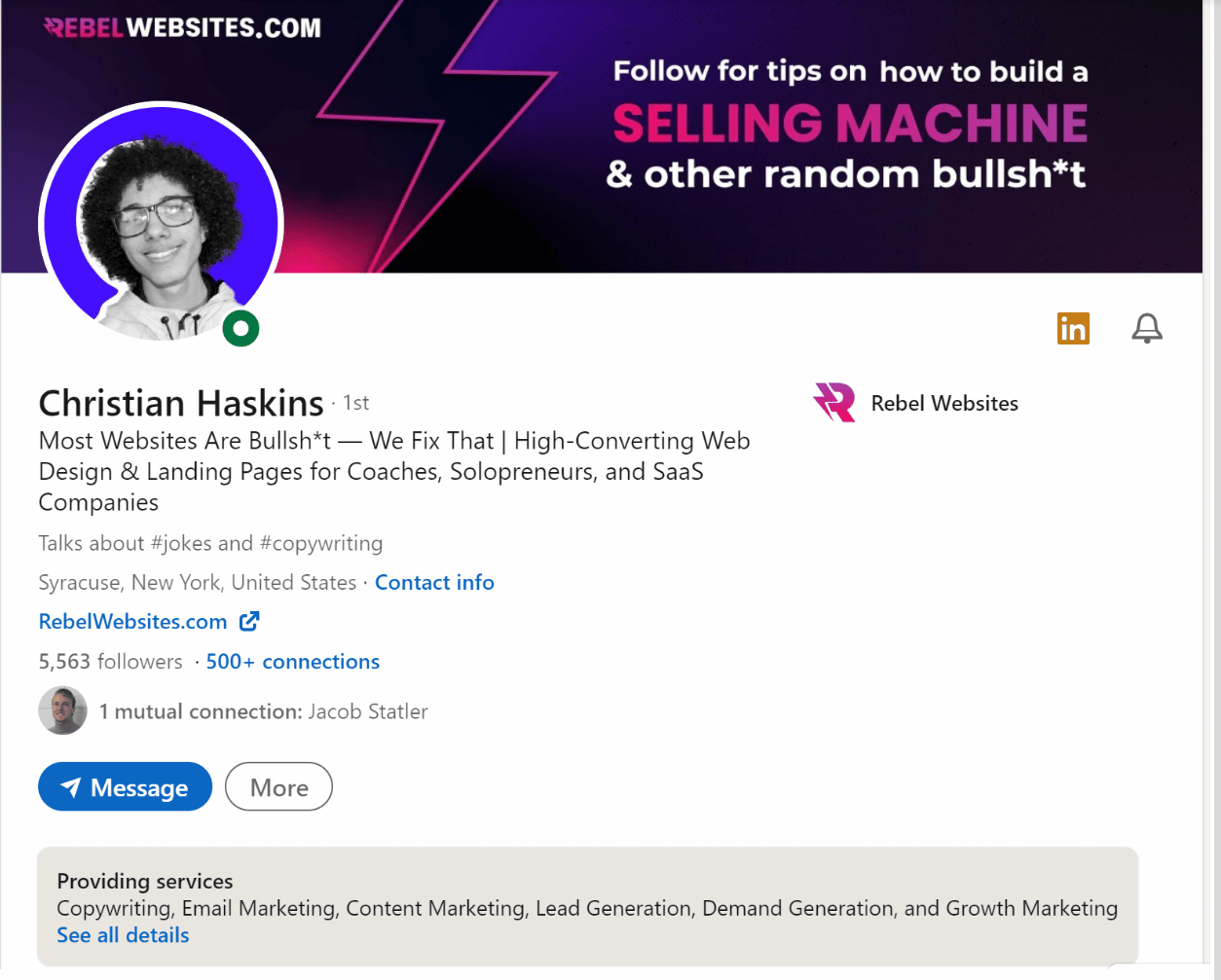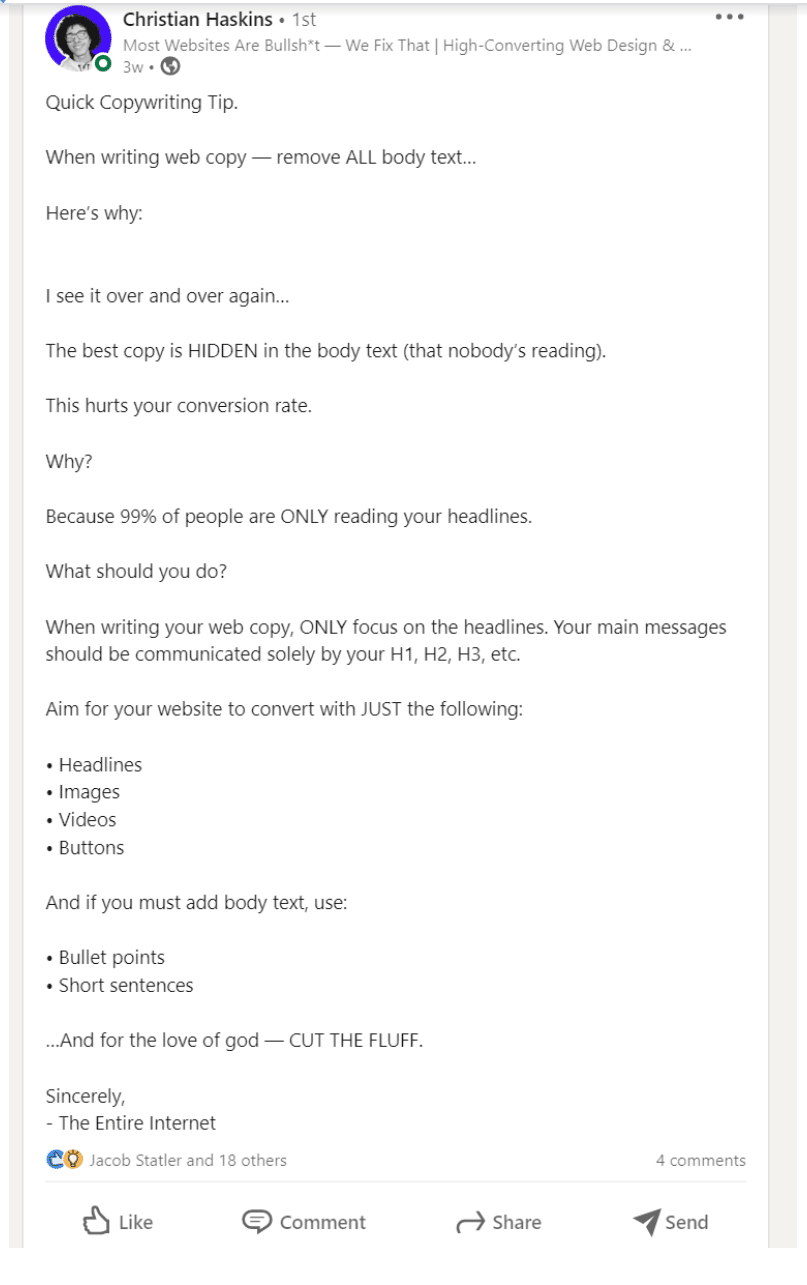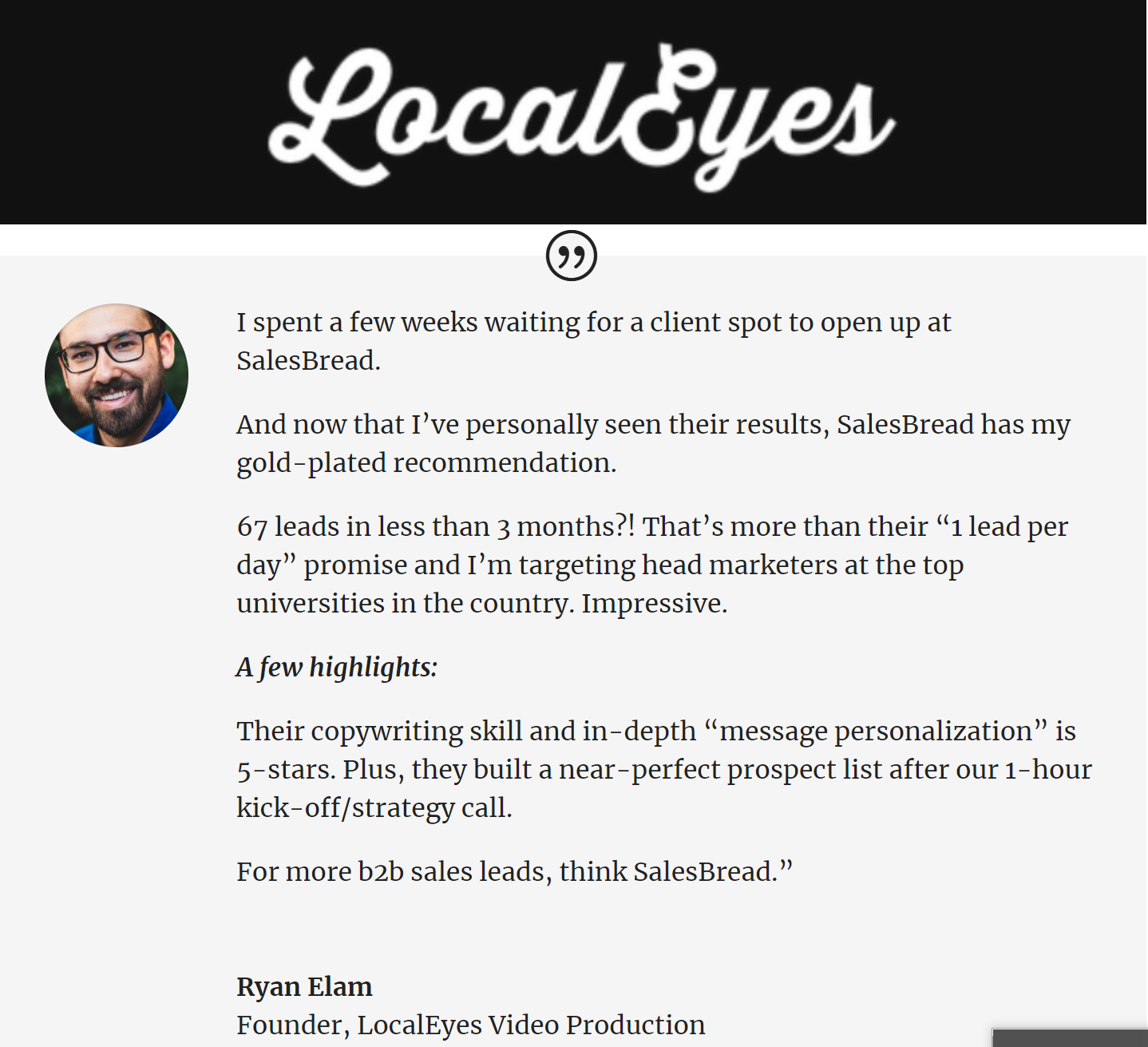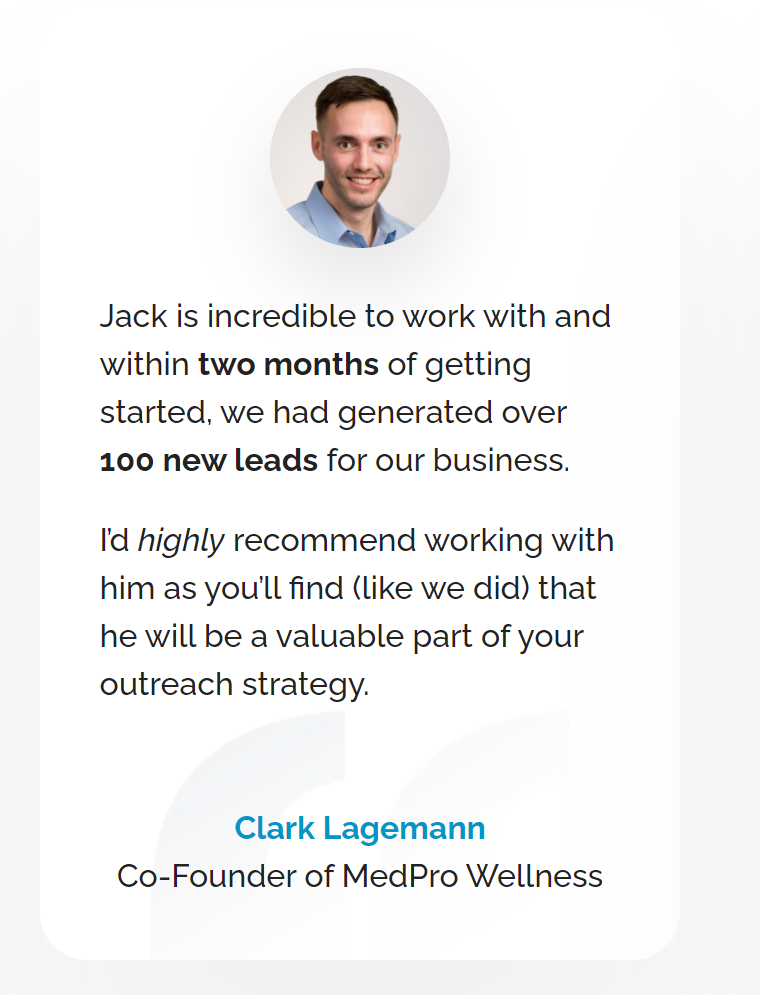At Salesbread we are often asked what’s the secret to generating 1 K + leads per year.
Besides having a killer lead generation strategy… We also use simple sales psychology.
If you can get into the minds of your ideal target audience, sales will be a whole lot easier.
In this article, we will discuss Robert Cialdini’s “Weapons of Influence,” and how you can use the psychology behind it to generate high-quality Linkedin leads.
(Whether using Linkedin Ads, Linkedin lead gen forms, or even direct outreach via messaging or Inmail. These principles apply to all forms of lead generation efforts. )
(At Salesbread we reach out to your ideal prospects on Linkedin by using ultra-personalized messages. No sleazy sales pitches, but rather messages that start conversations for you to get your foot in the door to sell your product/service. In 2021 we generated close to 5000 qualified leads for our clients. If this sounds good to you, let’s hop on a free 15-minute consultation call.)
First, make sure your Linkedin profile speaks volumes – People are going to have a look at your page.
As we mentioned in the intro of this article, your Linkedin profile can be used as a sales engine that keeps on generating new leads. But to get started, you have to have a professional Linkedin profile.
Your profile is the first thing that potential customers will check out before they even reply to your messages.
If your profile is unprofessional or doesn’t say much about what you do, people might not be interested in engaging with you.
View your profile as a sales page.
Be very specific about what you do, and use it to create social proof.
Below is an example of a Linkedin profile that “sells”.




What I love about the above page is that it’s different.
It immediately captures your attention because the language is so different from most “serious” business pages on Linkedin.
The company is obviously catering to a younger, more “woke” generation of founders and companies. But it catches your attention and gets to the point.
They help build beautiful websites, but also by using content that converts; Whether it’s video, lead magnets, and the like.
At the end of his profile, he also mentions that you can contact him directly on Linkedin.
Besides this, they post regular content on Linkedin that adds to their authority. Often their videos are catchy, as well as their posts.
From their content, you can tell that they know what they are doing.

Next, grow a PROFITABLE Linkedin network of people you would like to sell to.
Don’t just connect with anyone on Linkedin.
Initially, this might seem like a good idea because you’re growing your connections, but the issue comes in when you’re selling a saas product for real estate companies, but everyone in your network is in the health and wellness space.
See the problem?
Rather connect with people who are your ideal target audience. Build a network of people who you would like to sell to.
Think about it.
It wouldn’t help to have 1000 people in your network who are totally out of your market.
The easiest thing to do to get this right is to join industry-specific Linkedin groups that make sense for you to be a part of.
Once you get accepted, it’s pretty easy to say something like:
“Hey Susan, I saw you from the online marketer community on Linkedin, seems like we have some overlap, and we know many of the same people would love to connect.”
This kind of message is going to get accepted. As your second-degree network grows and grows, life gets easier.
Another option is to post some content on your Linkedin feed; whoever replies, send them an invitation.
But there is a caveat here, people who might reply to your posts, might not be your ideal prospect. So you might want to vet who you reach out to and who you don’t.
Once you have reached out to your “low-hanging fruit” you should have about 500 new connections.
At this stage, you can reach out to people with different job titles, as long as they are still in the same industry as your ideal buyer.
Why?
Because they will most probably be connected to a whole lot of people whom you would want to reach out to.
Next, reach out to your “dream connections” in the industry that you have infiltrated. These are the people that you would like to sell to later.
Don’t try to sell to them as soon as you connect with them because nobody wants to get pitched to. If you do this in your invite message, they will ignore you.
So how do you build connections with your dream clients?
- Make a list of all the businesses that you would like to do business with.
- Look at second-degree connections at those companies that start to have the right department, job title, or keyword at that company. Now everyone who accepts your invite, sees that you have shared connections because they are second-degree.
- You can then reach out to them with personalized messages.
Rather have a smaller network on Linkedin who love what you have to say, than hundreds of people who don’t really care.
1. Become an authority figure in your market – It’s easier to sell when people know and trust you.
Remember, sales is about trust.
Either people come to you because you have come recommended, or people think that you are the “go-to person” in the market.
So what does this have to do with becoming an authority figure?
Well, if you can use your Linkedin account (or any other means, like webinars or cold email) to soften the ground first, you should have a far easier time winning quality leads over when you start sending them outreach messages over Linkedin.
Because when they see a message from you or a connection request, they are going to think: “Oh yeah, I know this person, they did a webinar on xzy. Or “I remember their post on Linkedin about XYZ.”
When people recognize you as the authority figure in your niche it makes sales a whole lot easier.
This means that when people think of “Linkedin lead generation experts” (for example) they will think of Jack from Salesbread.
Or with the above example of web designers, they will think of Christian Haskins.
Best tips for building authority in your niche
Write a book
Write and publish a book about your niche because when people read it, they will know that you know what you’re talking about, and in their eyes, you become an authority figure.
Promote your content on Linkedin.
Whether it’s a book, an article, or a presentation. Make sure that you post often on the platform about your niche so that Linkedin users see you all the time.
Have a look at the example below:


Notice the engagement Jess receives when she posts.
This 1 post generated 48 comments. She posts almost daily with something interesting and unique to share.
By constantly being in front of your network, and posting VALUABLE content, she becomes an authority figure in the world of content marketing.
Name-drop big companies you have worked with
In your Linkedin profile share which big companies you have worked with. This helps followers see that “big names” have used your services, or that you have partnered up with these big companies in the past.
See the example below:

Land yourself interviews, guest posts, and presentations
Use your Linkedin profile or posts to establish yourself as the authority figure in your space by landing yourself interviews, presentations, guest posts, speaking gigs, and virtual summits; so that anyone listening, watching, or reading, will say that “yep, this person is the go-to.
Have someone else promote you as the authority.
We have noticed that some agencies even email certain companies and ask if a certain authority figure or influencer can speak at a webinar for their business; Or be a guest speaker on a podcast.
It can take time to become an authority in your niche, but, while you are growing your authority, you can use the following Linkedin lead generation strategies and the psychology behind it to get prospects to reply.

2. Start conversations with your prospects – It creates trust and unity
No one wants to hear a sleazy sales pitch.
When people think that you want to sell them something they switch off from what you have to say.
But remember, humans, are social creatures. We have a strong desire to be part of a group, a community, and a family. Cialdini mentioned the “unity principle” in this regard.
What does this mean?
We all have a desire for shared identities. We all want to have strong relationships with others.
We trust our friends and families because we have a bond with them.
So if you as a b2b marketer can make your prospect feel as if you’re really interested in them, they will be more likely to trust you.
This is why we never pitch a sale in our lead generation campaigns. All we do is start conversations with people.
By starting conversations, as if you were their friend gives you a greater chance of them replying to your outreach message.
Here’s an example:
“Hey Jack, I really enjoyed your podcast on XYZ, especially the point about { point}. Would love to connect with you..”
Once they reply, you can then send a follow-up message:
“Thanks for connecting, by the way, I’m curious to hear how your company deals with {prospects’ pain point}? For background, my company does {xyz}. Do you think this would be worth a quick chat? Ps: I’d be happy to introduce you to anyone in my network.
NOTICE:
- There is no sleazy sales pitch
- We talk about the prospect 90% of the time
- And we discuss their pain points.
- Also, notice how we complemented the prospect ( see our CCQ method) on their podcast and offered a value add of introducing them to someone in our network.
When people think that you’re interested in them, they will respond. Especially if you took the time to add personalization to your message.
It stands out from every other sales message out there on Linkedin.
3. Reciprocity – People don’t like feeling indebted to others
When someone offers a gift, oftentimes we feel like we need to reciprocate the gesture. There are various case studies that prove this.
An example is Cornell University’s “Coke experiment.”
Which went as follows:

So offer your prospects something of value for free.
Whether it’s introducing them to someone in your Linkedin network who can further their career, or offering them to be a guest on your podcast (which is basically free advertising).
Or anything else really. People feel indebted when they receive something as a gift.
Side note: The “gift” should be for free with no strings attached. So when you do ask for the prospect to take action, whether it’s agreeing to a sales call, or demo the chances of them saying yes will be higher.
1. Send a download link to a free report or ebook. For example, at Salesbread if you sign up for our monthly email list, we will send you a free pdf document with all our best tips for Linkedin lead generation, as well as hundreds of free templates.
2. Write an actionable how-to email that helps your readers solve a problem and send it to them. You could even mention this in your Linkedin news feed and direct readers to a blog that discusses how to solve the problem they might be facing.
3. Invite your readers to a webinar where you answer your subscribers’ questions live.
4. Share a link to a podcast with a relevant industry leader that will benefit your readers or followers.
5. Ask your Linkedin followers or connections to share their thoughts on what they are struggling with and take time to reply with personalized, helpful tips
4. Commitment – Consistency is key
Prospects need to see you as consistent. Consistency means that we follow through and do as we say we will.
And when we come across as consistent, Robert Cialdini says that it is associated with personal and intellectual strength.
People will be more prone to trust us if we are consistent.
For example, if you promise a free PDF on SEO, make sure to send it to your prospect. You need to find ways to get your ideal buyer to “commit” to you.
Whether it’s signing up for your “Linkedin marketing” newsletter, or agreeing to vote in a poll for a competition.
Remember once a prospect commits to something, it’s important to follow through and reward them for their efforts.
These small steps eventually will allow you to have a “bigger ask”. Like hopping on a sales call.
5. Social Proof – People do what they see others are doing
Have you ever had a look at an Instagram account, and there are hundreds of comments on how a specific product has helped the person?
For example:
There was a recently released organic skincare range that was taking the market by storm.
The marketing team did an excellent job because I saw this brand pop up constantly on my Instagram feed.
Eventually, tons of testimonials came through on how incredible this skincare range was, and how beneficial it is for the environment and your skin. There were hundreds of before and after photos and customer reviews.
So, guess what?
I decided to purchase the product. Mainly because customers were praising how incredible this product was…
Fast forward 6 months later, the product was awful for my skin, as well as for many of my friends.
If it wasn’t for the amount of social proof that the company was sharing, I probably would never have tried it.
Social proof proves over and over again that when a product comes across as “excellent” from other consumers, the chances of people wanting to try it will be high.
Why?
Because we think, “it worked for so many other people, it might work just as well for me.”
We do what others do.

So if you are a b2b company, share your success on your social media pages, or on your website. Whether it’s in the form of testimonials, case studies that flaunt your metrics, or even by name-dropping big companies that you have worked with.
Below are some examples that we have used for social proof on our website:




According to Hubspot, 88% of consumers trust customer reviews.
Here are some other mind-blowing stats on social proof:
- The average consumer reads 10 online reviews before making a purchase decision.
- 57% of consumers will only buy or use a business service if it has at least a 4-star rating.
- For 50% of all consumers, their very next step after reading a positive review about a company is to visit their website.
6. Scarcity – Opportunities seem more valuable to us when their availability is limited.
When there is a limited offer available, it entices people to act. Have a look at the example below:
On bookings.com they have a little section in the ad that mentions how many rooms are left.
This home already has a discounted rate, and they mention “only 2 rooms left at this price.” The loss of availability makes it more desirable to the customer.

Remember, when supply goes down (scarcity increases) then the demand (and price) go up.
Why?
Because if you can increase scarcity on a highly demanded service or product you can demand a higher price point.
If you sell a product or service, find a way to increase scarcity to sell more.
How do you do this?
Well, you could open a course registration for a limited time only, add time-sensitive bonuses or increase the price at a defined date in the future to increase scarcity for your products/services.
You can also offer your service or product to a limited number of clients and close the doors once you’re sold out.
7. Liking – People are more likely to buy from you if they like you.
Remember the sleazy sales pitch?
Quick story: (Feel free to skip it.)
A while back, there was a hair salon that just opened in a mall close to where I stay. Whilst doing my weekly grocery shopping I got ambushed by a very enthusiastic hairstylist.
If I paid a certain amount of money for a loyalty card, I could get a discount on my first appointment.
I kindly said no, as I didn’t want to pay for a loyalty card, AND I was in a rush.
The hairstylist followed me around as I walked trying to sell me the card. (As you can imagine, quite annoying.) Eventually, he told me “Your face is so grumpy you should just smile.”
At this point, I lost my temper and chose a few choice words to let him know that in no way will I ever go to his salon.
Why?
Because he was ridiculously pushy and rude. Because of this, I was never even curious to check out the new salon.
I’m sure that you as a reader have experienced similar attempts from pushy sales teams. Probably leaving you irritated and frustrated.
Especially if you are in a hurry and they are forcing you to buy a service that you don’t need or want.
In short, this guy was super annoying and rude. (And I’m a really patient person by nature.)
So in your sales don’t be the annoying pushy salesperson.
Prospects will be more likely to buy from you if they like you. Remember the golden rule. Treat people in the same way that you would like to be treated.
“People are more likely to comply with requests made by someone they like.”
This is why social media marketing done by influencers and celebrities does so well.
So get to know your ideal target audience very well in your marketing strategy. When it comes to outreach, read their profiles.
What are their likes? Dislikes? Are they part of any humanitarian causes? What similarities do you have with your prospects that you can use in your copy?
Get them to like you.
This will lead to more sales.
Don’t have the time to do lead generation?
We know that drafting the perfect LinkedIn campaign takes time.
You have to build an ideal list of prospects, read each profile to write personalized messages, and follow up.
If you enjoy doing lead generation then great, but if it’s something that isn’t your particular cup of tea, and you don’t have the time, reach out to us for a free 15-minute sales call.
